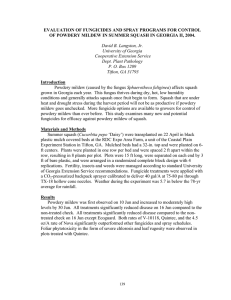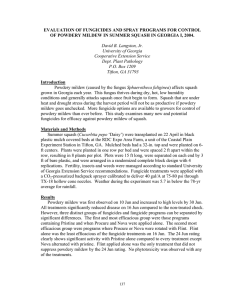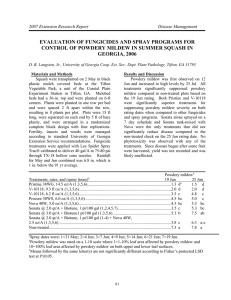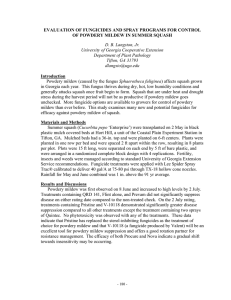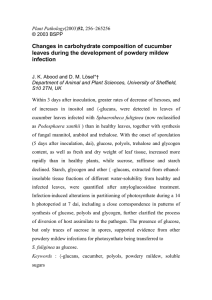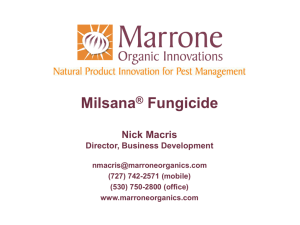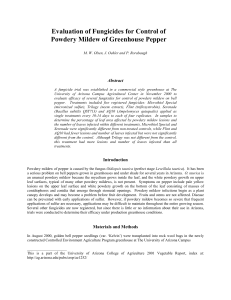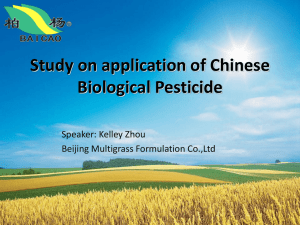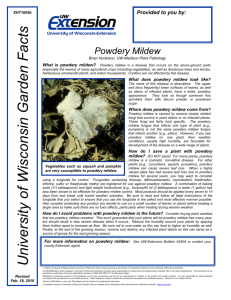ROTATION OF BIOCIDES WITH POWDERY MILDEW FUNGICIDES TO SUPPRESS Introduction
advertisement
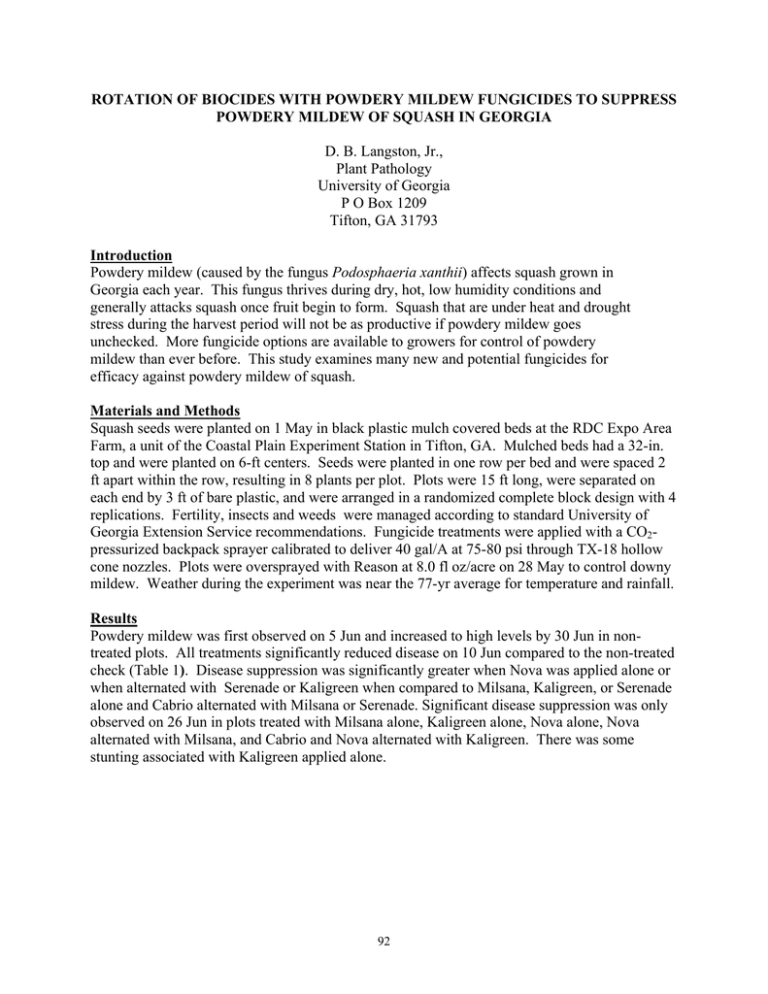
ROTATION OF BIOCIDES WITH POWDERY MILDEW FUNGICIDES TO SUPPRESS POWDERY MILDEW OF SQUASH IN GEORGIA D. B. Langston, Jr., Plant Pathology University of Georgia P O Box 1209 Tifton, GA 31793 Introduction Powdery mildew (caused by the fungus Podosphaeria xanthii) affects squash grown in Georgia each year. This fungus thrives during dry, hot, low humidity conditions and generally attacks squash once fruit begin to form. Squash that are under heat and drought stress during the harvest period will not be as productive if powdery mildew goes unchecked. More fungicide options are available to growers for control of powdery mildew than ever before. This study examines many new and potential fungicides for efficacy against powdery mildew of squash. Materials and Methods Squash seeds were planted on 1 May in black plastic mulch covered beds at the RDC Expo Area Farm, a unit of the Coastal Plain Experiment Station in Tifton, GA. Mulched beds had a 32-in. top and were planted on 6-ft centers. Seeds were planted in one row per bed and were spaced 2 ft apart within the row, resulting in 8 plants per plot. Plots were 15 ft long, were separated on each end by 3 ft of bare plastic, and were arranged in a randomized complete block design with 4 replications. Fertility, insects and weeds were managed according to standard University of Georgia Extension Service recommendations. Fungicide treatments were applied with a CO2pressurized backpack sprayer calibrated to deliver 40 gal/A at 75-80 psi through TX-18 hollow cone nozzles. Plots were oversprayed with Reason at 8.0 fl oz/acre on 28 May to control downy mildew. Weather during the experiment was near the 77-yr average for temperature and rainfall. Results Powdery mildew was first observed on 5 Jun and increased to high levels by 30 Jun in nontreated plots. All treatments significantly reduced disease on 10 Jun compared to the non-treated check (Table 1). Disease suppression was significantly greater when Nova was applied alone or when alternated with Serenade or Kaligreen when compared to Milsana, Kaligreen, or Serenade alone and Cabrio alternated with Milsana or Serenade. Significant disease suppression was only observed on 26 Jun in plots treated with Milsana alone, Kaligreen alone, Nova alone, Nova alternated with Milsana, and Cabrio and Nova alternated with Kaligreen. There was some stunting associated with Kaligreen applied alone. 92 Table 1. Effect of fungicides and biopesticides on powdery mildew severity. Treatments, rates, and (spray times) Powdery mildewy 10 Jun 26 Jun z Milsana, 0.5% v/v + Tween 20, 0.02% v/v (1-4)..........................4.0 bx 6.8 bc Kaligreen 82%, 3.0 lb/A (1-4) ......................................................3.4 bc 4.8 e Cabrio 20EG, 12.0 oz/A (1-4).......................................................3.0 b-d 8.0 ab Nova 40W, 4.0 oz/A (1-4) ............................................................1.5 e 5.0 de Serenade WP, 4.0 lb/100 gal (1-4)................................................3.6 b 8.8 a Cabrio 20EG, 12.0 oz/A (1, 3) Milsana, 0.5% v/v + Tween 20, 0.02% v/v (2, 4) .........................3.4 bc 9.0 a Nova 40W, 4.0 oz/A (1, 3) Milsana, 0.5% v/v + Tween 20, 0.02% v/v (2, 4) .........................2.5 c-e 6.5 b-d Cabrio 20EG, 12.0 oz/A (1, 3) Kaligreen 82%, 3.0 lb/A (2, 4)......................................................2.4 c-e 6.8 bc Nova 40W, 4.0 oz/A (1, 3) Kaligreen 82%, 3.0 lb/A (2, 4)......................................................2.3 de 5.8 c-e Cabrio 20EG, 12.0 oz/A (1, 3) Serenade WP, 4.0 lb/100 gal (2, 4) ...............................................3.9 b 7.8 ab Nova 40W, 4.0 oz/A (1, 3) Serenade WP 4.0 lb/100 gal (2, 4) ................................................2.1 de 8.0 ab Non-treated ...................................................................................5.8 a 9.3 a z Spray dates were: 1=28 May; 2=5 Jun; 3=13 Jun; 4=20 Jun. Powdery mildew was rated on a 1-10 scale where 1=1-10% leaf area affected by powdery mildew and 10=100% leaf area affected by powdery mildew on both leaf surfaces. x Means followed by the same letter(s) are not significantly different according to Fisher’s protected LSD test at P≤0.05. y 93
